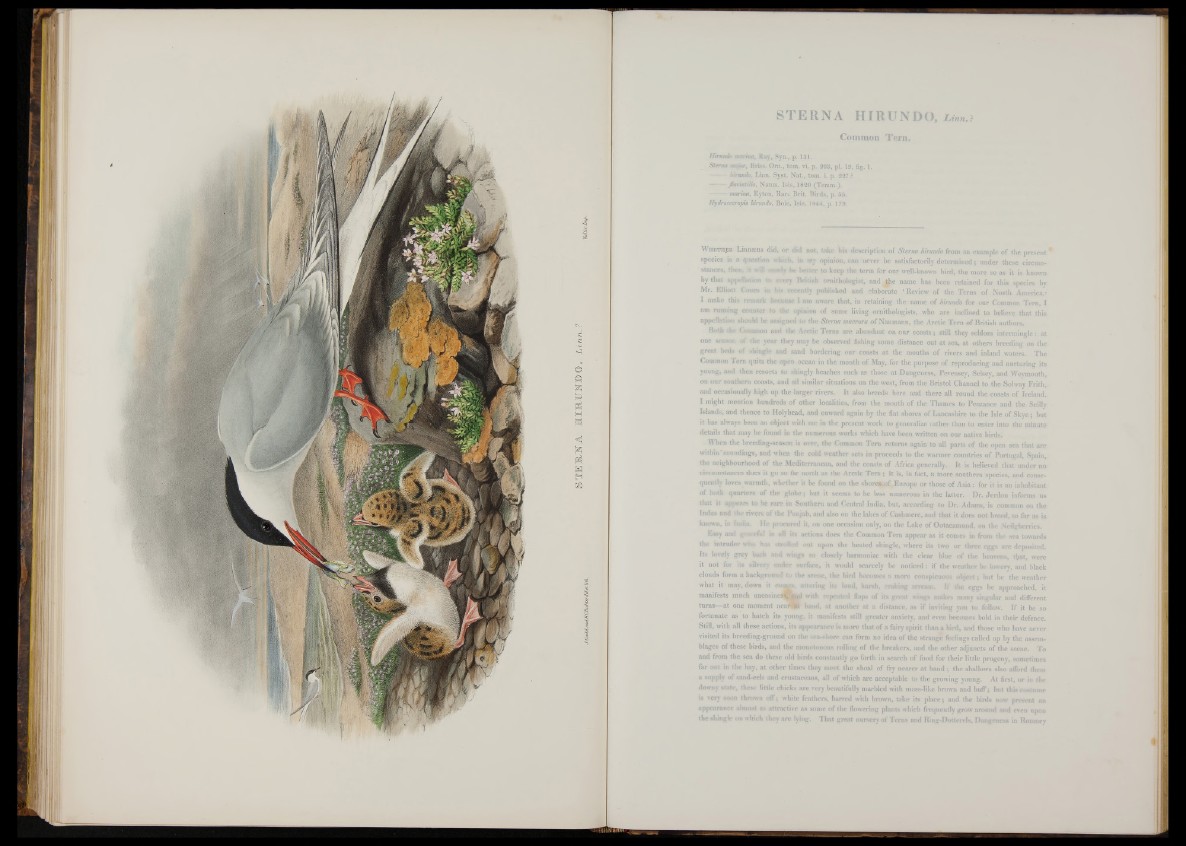
S TTRTOTA H IR T IIB -O
STERNA HIRUN
Common Tern
Birundo marina, Ray, Syn., p. 131.
Stem» major, Briss. Ora., tom. vi. p. 203, pi. 19. fig. 1.
nirvndo, Linn. Syst. Nat., tom. i. p. 227 ?
Jhmatilis, Naum. Isis, 1820 (Temm.).
marina, Eyton, Rare Brit. Birds, p. 56.
Bydroceeropis hirundo, Boie, Isis, 1844, p. 179.
W h e t h e r Linnaeus did, or did not, l a k e his description o f Sterna hirando from an example o f the present
species is a question which, in my opinion, can never be satisfactorily determined; under these circumstances,
then, it mVt wrely be l»wter to keep the term for our well-known bird, the more so as it is known
by that appellation to every British ornithologist, and the name has been retained for this species by
Mr. Elliott Cones in his recently published and elaborate ‘ Review o f the Terns of North America.’
I make this remark because I am aware that, in retaining the name o f hirundo for our Common Tern, I
am running counter to the opinion o f some living ornithologists, who are inclined to believe that this
appellation should be assigned to the Sterna macrura o f Naumann, the Arctic Tern o f British authors.
Both the Common and the Arctic Terns are abundant on our coasts; still they seldom intermingle: at
one season o? the year they may be observed fishing some distance out at sea, at others breeding on the
great beds o f shingle and sand bordering our coasts at the mouths o f rivers and inland waters. The
Common Tern quits the open ocean in the month of May, for the purpose o f reproducing and nurturing its
young, and then resorts to shingly beaches such as those at Dungeness, Pevensey, Selsey, and Weymouth,
on our southern coasts, and all similar situations on the west, from the Bristol Channel to the Solway Frith,
and occasionally high up the larger rivers. It also breeds here and there all round the coasts o f Ireland.
I might mention hundreds o f other localities, from the mouth o f the Thames to Penzance and the Scilly
Islands, and thence to Holyhead, and onward again by the flat shores o f Lancashire to the Isle of Skye; but
it has always been an object with me in the present work to generalize rather than to enter into the minute
details that may be found in the numerous works which have been written on our native birds.
When the breeding-season is over, the Common Tern returns again to all parts o f the open sea that are
within' soundings, and when the cold weather sets in proceeds to the warmer countries o f Portugal, Spain,
the neighbourhood of the Mediterranean, and the coasts o f Africa generally. It is believed that under no
circumstances does it go so far north as the Arctic Tern ; it is, in fact, a more southern species, and consequently
loves warmth, whether it be found on the shores, o f Europe or those o f Asia: for it is an inhabitant
o f both quarters o f the globe; but it seems to be less numerous in the latter. Dr. Jerdon informs us
that it appears to he rare in Southern and Central India, but, according to Dr. Adams, is common on the
Indus and the rivers o f the Punjab, and also on the lakes o f Cashmere, and that it does not breed, so far as is
known, in India. He procured it, on one occasion only, on the Lake o f Ootacamund, on the Neilgherries.
Easy and gm^ful in all its actions does the Common Tern appear as it conies in from the sea towards
the intruder who has strolled out upon the heated shingle, where its two or three eggs are deposited.
Its lovely grey hack and wings so closely harmonize with the clear blue o f the heavens, that, were
it not for its silvery under surface, it would scarcely be noticed: if the weather be iowery, and black
clouds form a background to the scene, the bird becomes a more conspicuous object; but be the weather
what it may, down it comes, ottering its loud, harsh, eraking scream, if the eggs be approached, it
manifests much uneasinedHhrf with repeated flaps o f its great wings makes many singular and different
turns at one moment ncari\-ftt hand, at another at a distance, as if inviting you to follow. If it be so
fortunate as to hatch its young, it manifests still greater anxiety, and even becomes bold in their defence.
Still, with all these actions, its appearance is more that o f a fairy spirit than a bird, and those who have never
visited its breeding-ground on the sea-shore can form no idea o f the strange feelings called up by the assemblages
o f these birds, and the monotonous rolling o f the breakers, and the other adjuncts o f the scene. To
and from the sea do these old birds constantly go forth in search o f food for their little progeny, sometimes
far out in the bay, at other times they meet the shoal o f fry nearer at hand ; the shallows also afford them
a supply of sand-eels and crustaceans, all o f which are acceptable to the growing young. At first, or iu the
downy stair, these little chicks are very beautifully marbled with moss-like brown and buff; but this costume
is very soon thrown o ff; white feathers, barred with brown, take its place; and the birds now present an
appearance almost as attractive as some o f the flowering plants which frequently grow around and even upon
the shingle on which they are lying. That great nursery o f Terns and Ring-Dotterels, Dungeness in Romney